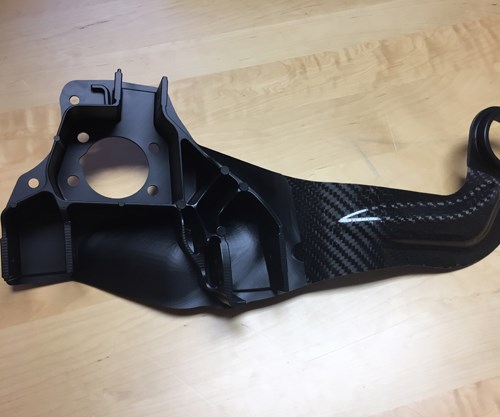Ford assesses SMC/prepreg suspension knuckle to replace metal
Ford Motor Co.'s Dunton Technical Centre in the UK has developed an SMC/compression molded carbon fiber replacement for a steel suspension knuckle. The part has production viability.

Part of the composite knuckle developed by Ford Motor Co.'s Dunton Technical Centre in Essex, UK.
Ford Motor Co. (Dunton, UK) has published a report describing a research and development effort to manufacture a carbon fiber composite rear suspension knuckle for a C-segment vehicle.
The project was undertaken by Ford’s Dunton Technical Centre (Essex, UK), Warwick Manufacturing Group (University of Warwick, UK), Gestamp (Newton Aycliffe, UK) and GRM Consulting (Leamington Spa, UK), and was designed to assess the feasibility of a composite knuckle replacing a steel predecessor.
The project, partially funded by Innovate UK and called Composite Lightweight Automobile Suspension System (CLASS), produced a composite structure comprised of carbon fiber/vinyl ester SMC with tailored reinforcement provided by a carbon fiber/epoxy prepreg. It is manufactured via compression molding with an- under 5-minute cure and weighs 50% less than the all-steel version. The composite part had to accommodate metallic fasteners, meet current hard point locations, and comply with Ford Motor Co. noise, vibration and handling (NVH) requirements.

Steel knuckle that the composite knuckle is designed to replace.
Yatish Chandra, one of the report’s authors and a composites CAE engineer, Research and Advanced Group at Ford, says the CLASS project was facilitated in part by GRM’s finite element analysis (FEA) optimization, which accelerated layup schedule development. This helped identify the need for prepreg, which was selectively applied to the knuckle to resist buckling and compressive stresses.
The production process starts with the building of a ply stack of prepreg sheets, followed by preforming and trimming. Preforms are then inserted into a mold with the SMC and the final part is then compression molded. Trimming and drilling follows to create holes to accommodate attachment points.
Yatish notes that the goal of the project was to develop a concept process with an aim to produce the knuckle in series at a rate of about 25,000 parts/year. It’s up to Ford now whether or not it will apply the composite knuckle to a production vehicle.
The authors of the report are:
- Alan Banks, supervisor, Ford Commercial Vehicle Chassis Group (Dunton)
- Emad Wahab, senior engineer, Ford Research and Advance Group (Dunton)
- Thomas Gerhards, research engineer, Ford Research and Advance Group (Aachen, Germany)
- Yatish Chandra, composites CAE engineer, Ford Research and Advance Group (Dunton).
Click “Composite-lightweight rear suspension knuckle for a high volume passenger vehicle” to download a copy of the report.
Related Content
-
Materials & Processes: Resin matrices for composites
The matrix binds the fiber reinforcement, gives the composite component its shape and determines its surface quality. A composite matrix may be a polymer, ceramic, metal or carbon. Here’s a guide to selection.
-
SMC simulation tool enhances design optimization
CAMX 2023: FiRMA, Engenuity’s new approach to SMC, uses a predictive technique that accurately reflects material properties and determine the performance range an SMC part or structure will exhibit.
-
Dieffenbacher highlights Fibercut system for increased productivity
Dieffenbacher’s fully automated cutting and stacking system enables automated SMC processing applications.
















